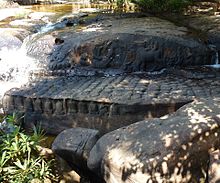| Kbal Spean | |
|---|---|
ក្បាលស្ពាន | |
 Lingas and sculptures of Hindu gods and waterfall at Kbal Spean | |
| Religion | |
| Affiliation | Hinduism |
| District | Siem Reap |
| Province | Siem Reap |
| Deity | Shiva and Vishnu |
| Location | |
| Location | Angkor |
| Country | Cambodia |
| Geographic coordinates | 13°42′30.1″N 104°1′32.1″E / 13.708361°N 104.025583°E |
| Architecture | |
| Type | Bapuon architecture |
| Creator | King Suryavarman I and King Udayadityavarman II[1] |
| Completed | 11th to 12th centuries[1] |
| Monument(s) | One |
Kbal Spean (Khmer: ក្បាលស្ពាន, Kbal Spéan [kɓaːl spiən]; lit. 'Bridge Head') is an Angkorian-era archaeological site on the southwest slopes of the Kulen Hills to the northeast of Angkor in Banteay Srei District, Siem Reap Province, Cambodia. It is situated along a 150m stretch of the Stung Kbal Spean River, 25 kilometres (16 mi) from the main Angkor group of monuments, which lie downstream.
The site consists of a series of stone rock relief carvings in sandstone formations of the river bed and banks. It is commonly known as the "Valley of a 1000 Lingas" or "The River of a Thousand Lingas". The motifs for stone carvings are mainly myriads of lingams (phallic symbol of Hindu god Shiva), depicted as neatly arranged bumps that cover the surface of a sandstone bed rock, and lingam-yoni designs. There are also various Hindu mythological motifs, including depictions of the gods Shiva, Vishnu, Brahma, Lakshmi, Rama, and Hanuman, as well as animals (cows and frogs).[1][2][3][4][5][6][7]
- ^ a b c Michael Freeman; Claude Jacques (25 January 2009). Ancient Angkor. River Books. pp. 216–217. ISBN 978-974-9863-81-7. Retrieved 20 May 2011.
{{cite book}}:|work=ignored (help) - ^ Tye, Timothy. "UNESCO World Heritage Site: Kbal Spean -Carved riverbed of ancient Angkor". asiaexplorers. Archived from the original on 7 July 2011. Retrieved 20 May 2011.
- ^ "Kbal Spean". Authority for the Protection and Management of Angkor and the Region of Siem Reap (APSARA). Archived from the original on 27 May 2012. Retrieved 20 May 2011.
- ^ Ray, Nick (2008). Angkor Wat and Siem Reap. Lonely Planet. p. 101. ISBN 978-1-74179-426-7.
- ^ Spooner, Andrew (17 June 2008). Footprint Cambodia. Footprint Travel Guides. pp. 106–107. ISBN 978-1-906098-15-5. Retrieved 20 May 2011.
- ^ Ray, Nick; Bloom, Greg; Robinson, Daniel (26 August 1967). Cambodia. Lonely Planet. pp. 190–. GGKEY:ALKFLS6LY8Y. Retrieved 20 May 2011.
- ^ Palmer, Beverley; Rough Guides (1 August 2002). The rough guide to Cambodia. Rough Guides. pp. 196–197. ISBN 978-1-85828-837-6. Retrieved 20 May 2011.
